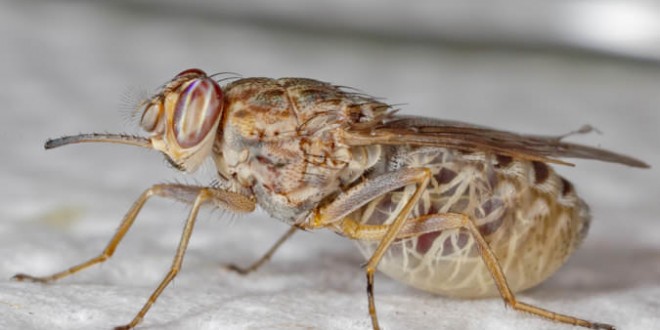An international team of scientists have sequenced the genome of the tsetse fly, which carries the parasite that causes sleeping sickness in humans the livestock version of the disease, called nagana.
The finding will help scientists to develop new ways of fighting the Trypanosomiasis, and endemic disease tha could be fatal without treatment.
Unlike most insects, tsetse flies produce one offspring at a time, which they feed by lactation before the larva is born. They feed exclusively on the blood of animals, and live comfortably with three different symbiotic bacteria including Wolbachia, which modulates insect reproduction. Comparing the genome of this fascinating species to other organisms can provide insights into evolutionary biology, for example the development of lactation in mammals. Most importantly, an in-depth understanding of the genetic makeup of the tsetse fly will help research into new ways of controlling the spread of sleeping sickness.
Beyond sequencing
Sequencing a genome is the first step in a long and complex process. Using computational methods, the scientists identified the genes that give instructions for making different proteins in the tsetse fly and compared them to other organisms. This comparison gives some indication of the function of the genes.
Over 140 insect disease vector biology scientists – half of whom work in African research institutes – examined and manually curated the annotations, bringing to bear their specialist knowledge in all aspects of tsetse fly biology, from sense of smell to reproduction and immunity. The result is a foundational resource for research into new ways of controlling the spread of sleeping sickness.
A community-driven resource
“This is a major milestone for the tsetse research community,” said Dr Geoffrey Attardo, research scientist at the Yale School of Public Health and lead author on the paper. “Our hope is that this resource will facilitate functional research and be an on-going contribution to the vector biology community.”
“The contribution of so many scientists, especially those from African countries where Glossina is a pest species, was key to unlocking the value of the genome annotations,” says Dan Lawson of EMBL-EBI. “Getting the community involved with genome projects early greatly improves the likelihood of long term utility of the resource.”
“I’ve loved being involved in this project from the very beginning,” says Karyn Megy of EMBL-EBI. “I’ve met great people who specialise in all aspects of vector disease, taken part in workshops with interesting people who are eager to learn, travelled several times to Africa and even went on a field trip in Kenya, to see how they capture the tsetse flies.”
Canadajournal/Press Releases
 Canada Journal – News of the World Articles and videos to bring you the biggest Canadian news stories from across the country every day
Canada Journal – News of the World Articles and videos to bring you the biggest Canadian news stories from across the country every day



